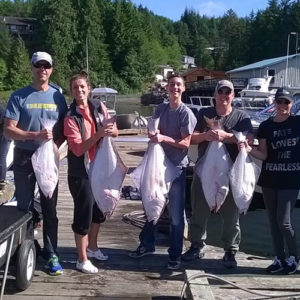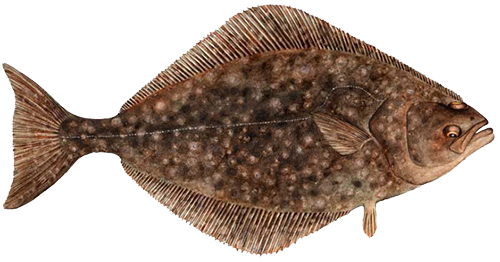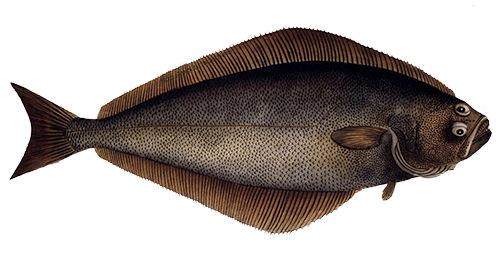The Best Time to Fish for Halibut in Ketchikan
Halibut fishing in Ketchikan Alaska provides some of the most exciting fishing in the world. Not to mention, Halibut taste great too.
Halibut in the waters of Ketchikan are the biggest fish you will find in the area, and they always put up a decent fight. Some of the larger catches can push the scales well over 300 pounds.
The halibut fishing industry forms a significant and vital part of the global seafood market. Halibut is a common sight in seafood markets and it regularly appears as an ingredient in tasty restaurant dishes around the world. Halibut meat is renowned for its mild flavor and high nutrient density as it contains a good amount of Omega-3 fatty acids, as well as high levels of protein, minerals, and vitamins.
 Halibut fishing is regulated to ensure the sustainability of the Halibut fishing industry for both commercial endeavors and the tourism industry. It is estimated that 70-million pounds of halibut are harvested every year, both commercially and recreationally. Halibut is also an important food source for native tribes and villages all over the coastal areas of Alaska.
Halibut fishing is regulated to ensure the sustainability of the Halibut fishing industry for both commercial endeavors and the tourism industry. It is estimated that 70-million pounds of halibut are harvested every year, both commercially and recreationally. Halibut is also an important food source for native tribes and villages all over the coastal areas of Alaska.
Here are a few tips on how to catch halibut in Ketchikan. This will help make your time with us more rewarding.
Immature halibut feed on plankton for their first year of life, but after that their diet will consist of crustaceans and small fish; just about anything which will fit in their mouths is fair game.
In Southeast Alaska, around Ketchikan, halibut prefer waters ranging in temperatures between 37 and 46 degrees Fahrenheit. As the months warm up, they will migrate into the shallower waters of the Continental Shelf and then move back out into the deeper waters for winter.
Halibut season in Ketchikan is from mid-May through to mid-September, but June through August is when they are most active and prolific.
Will You Catch a Halibut?
Mature halibut range in size between 48 and 80 inches and are sexually mature and able to reproduce. Regulations forbid us from keeping any fish that fall within that range to help maintain a sustainable halibut population.
But, you won’t have any problems when it comes to knowing what catches you can keep. Our experienced guides know what fish to keep and which ones should be thrown back.
There will always be plenty of opportunities to catch and keep a fish which falls outside of the prohibited range. Plus, you shouldn’t forget that it’s still fun to catch a halibut, even if you have to send back.
Interesting Halibut Facts
There are lots of interesting facts to know about the halibut. For instance, when they are born, all the fish are male, and they swim like any other fish does; upright and with eyes on either side of their head.
 Mature halibut swim on their side with their dark side facing upwards. As the fish matures, the eye on the right side migrates to the upward facing side of their body, which is a mottled dark brown in color.
Mature halibut swim on their side with their dark side facing upwards. As the fish matures, the eye on the right side migrates to the upward facing side of their body, which is a mottled dark brown in color.
The halibut lifespan can average 30 years and many can make it to the ripe old age of 50. Calcified deposits which form rings near the ears of the halibut will give you a clue as to the age of the fish, much like counting the rings of a tree.
Females carry the eggs necessary for spawning, and as the eggs can reach several million in number, it’s the female halibut which is the larger of the two genders. Spawning occurs in deep water, where the female will release several million eggs for the male to then fertilize with his sperm. Fertilized eggs usually take about 15 days to hatch.
The newly hatched halibut larvae will then float about, drifting on the deep ocean currents, while feeding on plankton along the way.
As they grow, the young halibut will move upwards until they reach the surface-level currents which will carry them to the more nutrient dense food sources found along the coastal areas of Alaska.
When halibut reach their sixth month of life, they will spend most of their time searching for food in the shallower waters close to shore. Once they reach sexual maturity, they will head to the deeper waters where they will spawn.
Tips on How to Catch Alaska Halibut
Halibut fishing is fun but not always easy. Fortunately, with these tips and our expert guides’ advice, you will have a good chance of enjoying a successful fishing trip.
 Getting the right fishing rod is an essential first step in learning how to catch halibut in Ketchikan. If you’re going after the biggest fish in Ketchikan waters, then you need a rod which can handle the strain. We use top-of-the-line professional equipment.
Getting the right fishing rod is an essential first step in learning how to catch halibut in Ketchikan. If you’re going after the biggest fish in Ketchikan waters, then you need a rod which can handle the strain. We use top-of-the-line professional equipment.
While they make use of sight to some degree, the halibut’s sense of smell is the predominant method used to locate their prey. Therefore, fresh, stinky bait is essential to attracting a fish to your line. The more your bait can stink up the water the better chance you have a landing a halibut.
Getting a halibut on your line will give you a decent arm workout for sure, especially if you catch what is known in the trade as a “barn door.” The large flat body creates an incredible amount of drag, and this is where the challenge lies when fishing for halibut.
The trick to successfully landing a halibut is to play it nice and slow and wait until the fish has entirely consumed your bait, at which time you increase the tension to set the hook.
Only when the pole has a decent enough bend to it should you start working at bringing the fish to the surface. Taking an aggressive stance too soon and jerking on the rod can cause you to lose the catch.
Types of Halibut
There are two species of halibut, the Pacific halibut (Hippoglossus stenolepis) which is the type you will be going after in the Alaskan Pacific around Ketchikan. The other member of the genus, Atlantic halibut (Hippoglossus hippoglossus) is the largest of the two species and lives in the North Atlantic Ocean.

Pacific Halibut
Pacific Halibut belong to the flatfish flounder family, which are a species of fish that swim sideways due to a laterally shaped body. Apart from a few exceptions, all halibut have both eyes situated on the right side of their head. Left-eyed examples are scarce, with estimates putting the number at 1 in 20,000.

Atlantic Halibut
Atlantic halibut can reach lengths up to 4.7m and weigh in at over 700 pounds. Atlantic halibut is currently listed as an endangered species due to recent overfishing and a slow rate of growth.

